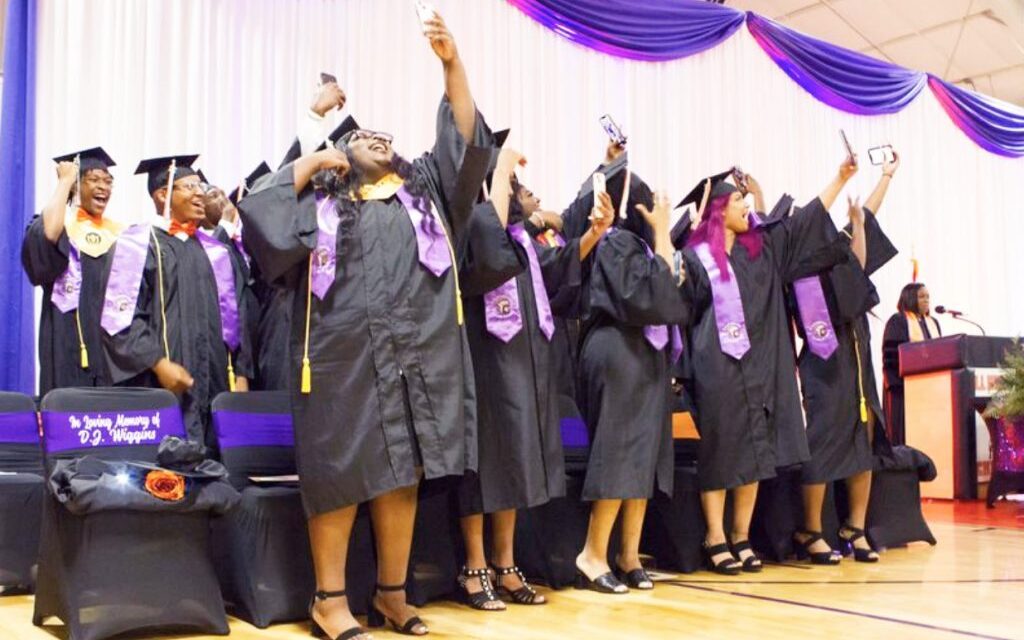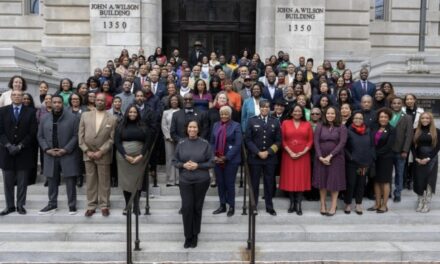By Rebecca Griesbach and Trisha Powell Crain, The Associated Press
Terra Johnson had no trouble picking out a graduation outfit Thursday evening.
The Lawrence County mom planned to wear a maroon jumpsuit in honor of her daughter’s college choice. All that was missing was the cowbell she’d gifted her a few days earlier, she joked.
“I won’t be as loud as I was on awards day,” Johnson said that morning, as she prepared for the ceremony.
Her daughter, Trinitee Johnson, had a lot to celebrate. The R.A. Hubbard senior is headed to Mississippi State University in the fall with a scholarship to study biomedical engineering.
She is the school’s valedictorian and homecoming queen – and is Hubbard’s last student to earn those honors. Hubbard will close this summer. Younger students and teachers will be moved out of the majority-Black high school, to other schools in Lawrence County. It’s a dilemma that hangs over many other rural, small schools in Alabama and around the country.
A federal judge recently ordered the small high school to close its doors – a decision that sparked debate and frustration among many community members.
“It’s a hard situation that the parents are put in,” said Terra Johnson, who also has a son who is a sophomore at the school. “We’re planted and rooted and invested in Hubbard.”
‘Planted and rooted’
R.A. Hubbard is the only majority-Black high school in Lawrence County. When the school closes, students will attend Hatton High, East Lawrence Middle or East Lawrence High. All three schools currently have a majority white student body.
For Trinitee Johnson, who came to R.A. Hubbard as a seventh grader, the school was a haven.
“Momma, I’ve never been at a school where I’ve seen a lot of people who looked like me,” Terra Johnson recalled Trinitee saying after her first day. Previously, she had gone to a predominantly white elementary school.
At Hubbard, Trinitee Johnson had teachers who knew who she was before she even walked in the door. They taught her about her culture, her mom said, in everyday conversations and in regular Black history programming. And they taught children that their opportunities were endless.
Her daughter took up band, joined the Beta club and took Latin classes while at Hubbard, and eventually earned the highest GPA in her class.
“They instilled in those kids that you can be something,” she said.
The Johnsons came to the school during a difficult time. R.A. Hubbard’s enrollment, like that of the county as a whole, was steadily declining.
The paper mill closed in 2014, taking 500 jobs and many families away from the Courtland community, close to where the school is located. Enrollment at R.A. Hubbard was 273 students in 2014. This year’s enrollment was 150 students in grades seven through 12.
In addition to losing half of its student population in a short time, the school landed on the state’s “failing schools” list in 2019 after earning an ‘F’ on the state report card. Students were free to go to nearby schools. Athletes who moved wouldn’t have to sit out a year, a typical requirement for moving from one school to another.
The school has been stuck on the list throughout the pandemic, regardless of the progress they made moving their grade from an ‘F’ to a ‘B’ the following year.
School improvement specialist AJ Buckner has worked with educators at R.A. Hubbard since mid-2020. He spent his entire career working in rural schools in Jackson County before becoming a member of the state department’s school improvement team.
He noted the school’s positive culture and its strong athletic tradition – which, some people fear, will soon dissolve as athletes split up into different schools.
“What people don’t know,” he said, “is the tenderness and the humility and the kindness and the family atmosphere that exists there that causes all that [athletic success] to happen. They encourage each other. They know that it’s a source of success.”
“They call it the R.A. Hubbard way,” Buckner said. If a student needs correcting, he said, staff remind them what is expected of them. “This is how you conduct yourself, and [students] know, and it’s a great source of pride for a standard that they live by.”
A ‘burden’ to bear
Officials have talked about closing R.A. Hubbard for a few years now, but the final decision wasn’t made until December, when the Lawrence County school board voted 4-1 to close the school.
Community members and the local NAACP chapter fought back against the state’s failing label and begged officials to keep the school open, to no avail.
The federal judge who approved the closure seemed swayed by the cost of keeping the small school open – more than $18,000 per student for the 2019-20 school year, according to court filings. That’s between $6,000 and $8,000 higher per student than at the district’s other three high schools.
Superintendent Jon Bret Smith, who was elected to the position in 2016 after teaching in the county since 2004, said there are academic and extracurricular opportunities available at the county’s other schools that are hard to offer at a small high school.
Experts, though, worry the fallout will be all too familiar.
“What we learned [from Brown vs. Board], was that the burden of school closures was felt, both socially and emotionally, mostly by Black students,” said Erica Edwards, an assistant professor of education at Wayne State University.
She said educators in closing schools can also face certain stigmas, and that school leaders should make sure that they are investing in culturally responsive practices to ensure a smoother transition for everyone.
“When these schools close and they begin going to white schools, emotionally you have to bear the brunt of difference: Being othered, being ostracized, having to prove yourself in ways that predominantly white communities don’t always understand or acknowledge or recognize,” she said.
Terra Johnson shares that concern for her son, who will have to go to a new school next year. Wherever he ends up, his commute will surely be longer, she said. And while he seems to have found a fit at one school, she’s doubted whether the whiter schools would welcome him in the same way that Hubbard did.
She definitely didn’t feel assured after a recent basketball game at one of the remaining majority-white high schools, where she said a group of students flashed a sign at Hubbard students that said “Get comfortable playing here.”
“I don’t think people are really sitting down and thinking about how [the closure is] affecting the kids,” she said. “It’s frightening to have to move to a new school. It’s not a good situation to put your child in, where your child is wondering, ‘How am I going to fit in?’”
Rural schools at risk
More than half of Alabama’s schools are located in rural areas, and R.A. Hubbard is not unlike most of them, Buckner said. Many are small, some with fewer than 100 students in multiple grades. These small schools are always at risk of being closed because they can be expensive to operate.
State funding provides the bare minimum based on student enrollment. This year, R.A. Hubbard was given state funding for fewer than eight teachers in grades 7 through 12.
Most rural schools are located in counties with low property tax support, meaning there’s no additional funding to offer any courses beyond the four-by-four standard curriculum and no money for extracurricular activities, either. R.A. Hubbard was fortunate, as their district has invested a lot of local tax dollars in the school to keep the school open.
But when a big employer closes – like International Paper in Courtland – people leave to find jobs elsewhere, Buckner said, further diminishing the resources of a community that may already be decimated by the loss of jobs and revenue for the school.
Buckner says it’s past time to figure out how to give students equal access to rigorous academics while also keeping rural schools open and vibrant. The value of a small, rural school where everybody knows each other can’t be understated, he said.
“Closing this school has a life-changing impact on the community and on every student that’s there and every teacher that’s there,” he said.

‘A life-changing impact’
At the ceremony Thursday, Buckner echoed the principal’s motto, asking students to remember what the school had taught them.
“I charge you to always be Chiefs and to always follow the R.A. Hubbard way,” he told the seniors.
Meanwhile, Trinitee Johnson fidgeted in one of the seats nearby. She had her own speech to deliver.
“I’m nervous,” she mouthed to her mother, who was sitting in the front row.
Trinitee Johnson walked toward the podium and past two empty chairs. They were adorned with candles and embroidered with the names of two classmates killed in a car accident last summer: Javion Brown and DJ Wiggins Jr.
“No other school in this county could have prepared me for certain situations I have experienced,” Trinitee Johnson told the crowd in her valedictory address. She turned to each of classmates, telling them how the time she was able to spend with them was the “best gift God has given me.”
“We did it y’all,” she said to them. “Even when it felt like we wouldn’t be able to. Even though we lost the backbones of our class. Even when we wanted to give up because nobody understood our hurt… we pushed through and we earned every little bit of our diplomas.”
The crowd cheered, and another senior, Kynlee Gillespie, approached the mic.
Gillespie’s classmates laughed along as she rattled off inside jokes and made some final, loving jabs at the teachers. And when she began to tear up, recalling the grief and loss that she and others endured this year, Trinitee Johnson and Principal Rosa Allen-Cooper rushed to comfort her.
Staff members called the night a “bittersweet moment,” and Ernest Williams, a local pastor who taught a math course to some of the students, offered some closing thoughts.
“Young minds, never stop dreaming,” he told the seniors. “They can close the school. But they can’t close your dreams.”
The seniors moved their tassels – pausing for the occasional selfie – as an alumni choir prepared to sing the school’s anthem one last time.
“By thy side we’ll stand and always praise thy name,” the choir belted. “…All aboard, all aboard, to Hubbard High.”
Beside them, the graduates swayed together until the final beat.










